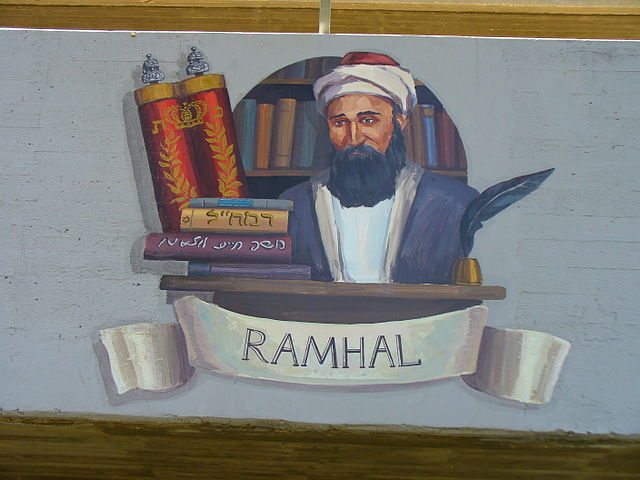
Wall painting of Moshe Chaim Luzzatto (aka Ramhal), at the wall of Akko’s Auditorium, Israel. | (c) en.wikipedia.org/wiki/Moshe_Chaim_Luzzatto
Rabbi Moshe Hayim Luzzatto, known as “ The RaMCHaL”, is one of the figures who thrived in Amsterdam, a city of refuge for many Jews, in the 18th century. But before we tackle his life in Amsterdam, let us get to know who the great Ramchal is and his contributions to our Jewish history.
If you’re interested in learning more about our Jewish history, consider joining some Jewish heritage tours with kosher riverboat cruises. Travel in style, experience kosher cuisine, and have the opportunity to connect more with your Jewish identity. Spend your Jewish vacation with us and book a trip today!
Early Life And Works
Rabbi Moshe Hayim Luzzatto was known as a genius child prodigy born in Padua, Italy. When he was still 14, he was able to write and publish his first book on linguistics and grammar. Not only this, but he had also written one of the first books that tackled the art of public speaking. When he turned 20, he became a member of a Kabbalistic group and started getting into mystic studies. Wherein he was seen to be excelling in and was considered to be ahead of his time.
Throughout his life, he has written remarkable works of Jewish literature that made an incredible impression during the 18th century. His most well-known book is entitled “Mesillat Yesharim,” which was deemed as a spectacular self-help book and an adept take on Jewish morality. His work was received well throughout the course of the 18th century and a wide range of individuals thoroughly enjoyed this piece of literature. Among them were notable figures such as Moses Mendelssohn and Joseph Klausner.
The Oath in Padua
A handful of university students studying in the University of Padua were especially interested in studying the Kabbalah and learning from him. As the Ramchal started to become more and more known for his teachings and more radical kabbalistic ideas, it stirred an excessive amount of unwarranted attention. The Ramchal was called out by Rabbi Moshe Hagiz, a relatively recognized figure, and accused him of being a secret follower of the false messiah, Shabbetai Tsvi. Rabbi Hagiz brought this issue forward to the Jewish court in Venice and the court scheduled a meeting with The Ramchal after realizing that he was too young to be studying the Kabbalah, still unmarried, and without a beard.
The meeting resulted in an Oath that the Ramchal had to take that would basically restrict him from teaching the Kabbalah. Even so, Rabbi Moshe Hayim’s desire to teach Kabbalah persisted. He decided to leave Padua and move to Frankfurt, Germany where he would continue his teachings. However, Rabbi Hagiz was dissatisfied with the lack of consequences given to the Ramchal. That is why he personally wrote a letter to Frankfurt, warning them about The Ramchal being a Sabbatean and telling them to arrest Rabbi Hayim on this suspicion.This led to another oath to be taken by the Ramchal restricting him from spreading more of his teachings. Not only this, but the court also seized his unpublished manuscripts in hopes of finding evidence of possible Heresy. Though they found no trace of Heresy, they were still unsure of the content of his work. Therefore, they buried the manuscripts and accidentally lost the site of burial.
Fortunately, a former teacher of the Ramchal, Rabbi Isaiah Basan, came to his defense. He argued that his student was not deserving of being punished under these suspicions. When the Ramchal took a second oath, the court finally allowed him to travel.
The Portuguese Jews of Amsterdam
Rabbi Moshe Hayim finally found a moment of peace in Amsterdam. The Portuguese Jews of Amsterdam offered him hospitality and treated him with the respect that he deserved. The Ramchal was given an honored position in society, a place to teach, and so much more. This was basically the start of some of the best years of his life as the Portuguese Jews in Amsterdam recognized and celebrated his brilliance. He had the freedom to study, write, and teach in Amsterdam which resulted in his most renowned and remarkable book entitled “Mesillat Yesharim,” or “The Path of The Just.”
In the 1990s, a newly discovered version was found in the archives of the former soviet union. This version was autographed and written in a dialogue version instead of the original thematic version that has been studied for years. The entire plot and theme was expressed in the dialogue of two old friends who have reunited after years being apart. Unfortunately, the Ramchal decided not to publish the dialogue version with the original existing version.
